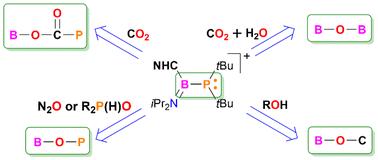当前位置:
X-MOL 学术
›
Dalton Trans.
›
论文详情
Our official English website, www.x-mol.net, welcomes your
feedback! (Note: you will need to create a separate account there.)
Activation of small molecules by ambiphilic NHC-stabilized phosphinoborenium cation: formation of boreniums with B–O–C, B–O–B, and B–O–P structural motifs
Dalton Transactions ( IF 3.5 ) Pub Date : 2024-11-08 , DOI: 10.1039/d4dt02656j Tomasz Wojnowski, Anna Ordyszewska, Hanna Halenka, Iwona Anusiewicz, Jarosław Chojnacki, Kinga Kaniewska-Laskowska, Rafał Grubba
Dalton Transactions ( IF 3.5 ) Pub Date : 2024-11-08 , DOI: 10.1039/d4dt02656j Tomasz Wojnowski, Anna Ordyszewska, Hanna Halenka, Iwona Anusiewicz, Jarosław Chojnacki, Kinga Kaniewska-Laskowska, Rafał Grubba

|
The reactivity of the phosphinoborenium cation supported by a 1,3,4,5-tetramethylimidazolin-2-ylidene ligand toward small molecules was explored. The phosphinoborenium cation exhibited dual Lewis acid–base properties due to the presence of the Lewis acidic boron center and the Lewis basic phosphido ligand connected by a covalent bond. The reaction of the title cation with CO2 led to the insertion of a CO2 molecule into the P–B bond. The obtained borenium CO2-adduct underwent hydrolysis, forming an N-heterocyclic carbene stabilized diborenium dication bearing a B–O–B functionality. The activation of N2O proceeded via the insertion of an oxygen atom into the B–P bond of the parent cation, yielding a borenium cation with a phosphinite moiety. An alternative synthetic pathway to borenium cations with a B–O–P skeleton was achieved via the activation of secondary phosphine oxides by the phosphinoborenium cation. Furthermore, borenium cations and diborenium dications with B–O–C structural motifs were obtained from the reaction of the title compound with perfluorinated tert-butyl alcohol and hydroquinone, respectively. The structure of the obtained borenium cations is discussed based on multinuclear NMR spectroscopy, X-ray diffraction, and density functional theory calculations.
中文翻译:

嗜性 NHC 稳定的膦硼鎓阳离子对小分子的激活:形成具有 B-O-C、B-O-B 和 B-O-P 结构基序的硼鎓
研究了由 1,3,4,5-四甲基咪唑啉-2-亚基配体支持的膦硼阳离子对小分子的反应性。由于存在 Lewis 酸性硼中心和通过共价键连接的 Lewis 碱性磷酸配体,膦硼烯阳离子表现出双重 Lewis 酸碱特性。标题阳离子与 CO2 的反应导致 CO2 分子插入 P-B 键。获得的硼 CO2-加合物发生水解,形成具有 B-O-B 官能团的 N-杂环卡宾稳定二硼烯。N2O 的活化是通过将氧原子插入母阳离子的 B-P 键中进行的,从而产生具有亚磷酸盐部分的钴阳离子。通过膦硼烯阳离子活化仲膦氧化物,实现了具有 B-O-P 骨架的硼阳离子的替代合成途径。此外,从标题化合物与全氟叔丁醇和对苯二酚的反应中,分别获得了具有 B-O-C 结构基序的硼阳离子和二硼烯离子。基于多核 NMR 波谱、X 射线衍射和密度泛函理论计算讨论了所获得的硼阳离子的结构。
更新日期:2024-11-08
中文翻译:

嗜性 NHC 稳定的膦硼鎓阳离子对小分子的激活:形成具有 B-O-C、B-O-B 和 B-O-P 结构基序的硼鎓
研究了由 1,3,4,5-四甲基咪唑啉-2-亚基配体支持的膦硼阳离子对小分子的反应性。由于存在 Lewis 酸性硼中心和通过共价键连接的 Lewis 碱性磷酸配体,膦硼烯阳离子表现出双重 Lewis 酸碱特性。标题阳离子与 CO2 的反应导致 CO2 分子插入 P-B 键。获得的硼 CO2-加合物发生水解,形成具有 B-O-B 官能团的 N-杂环卡宾稳定二硼烯。N2O 的活化是通过将氧原子插入母阳离子的 B-P 键中进行的,从而产生具有亚磷酸盐部分的钴阳离子。通过膦硼烯阳离子活化仲膦氧化物,实现了具有 B-O-P 骨架的硼阳离子的替代合成途径。此外,从标题化合物与全氟叔丁醇和对苯二酚的反应中,分别获得了具有 B-O-C 结构基序的硼阳离子和二硼烯离子。基于多核 NMR 波谱、X 射线衍射和密度泛函理论计算讨论了所获得的硼阳离子的结构。


















































 京公网安备 11010802027423号
京公网安备 11010802027423号